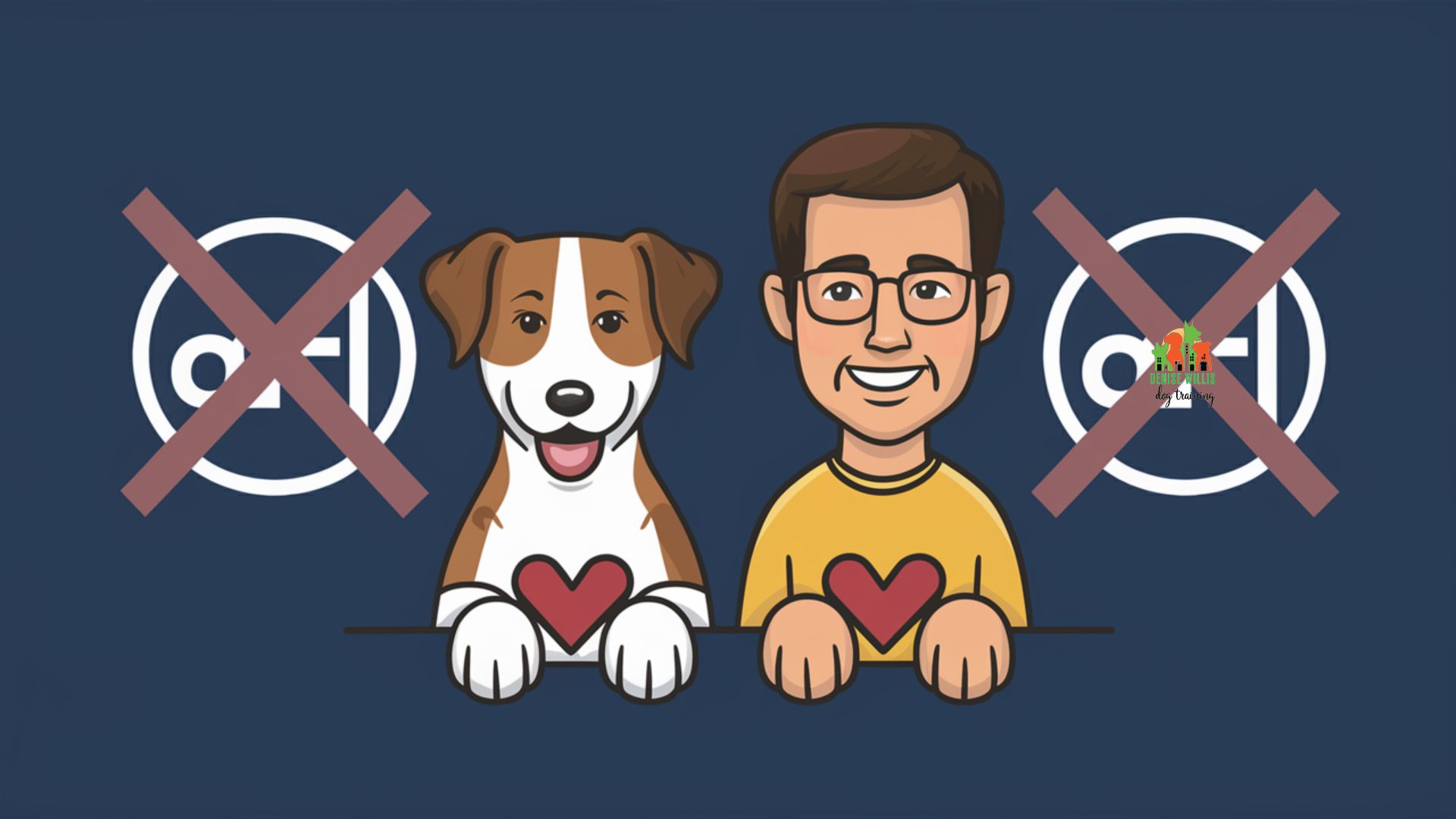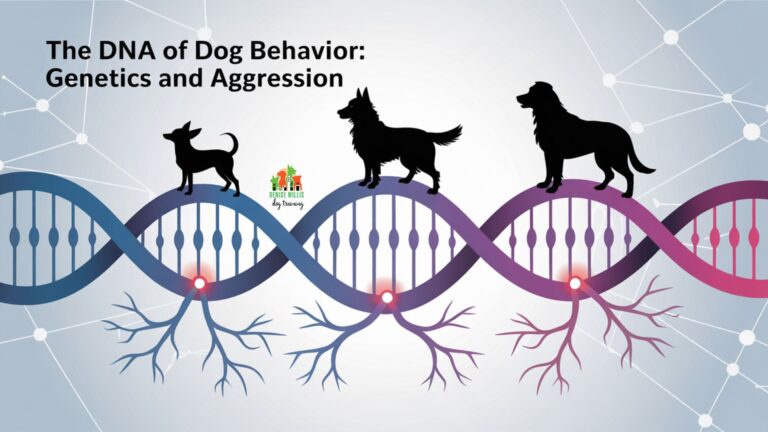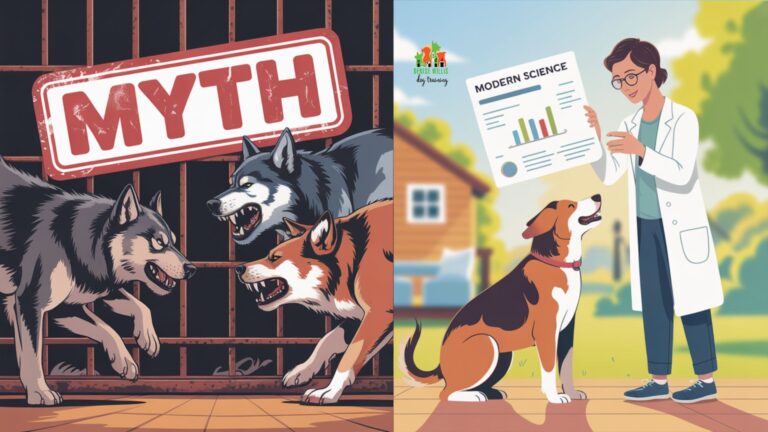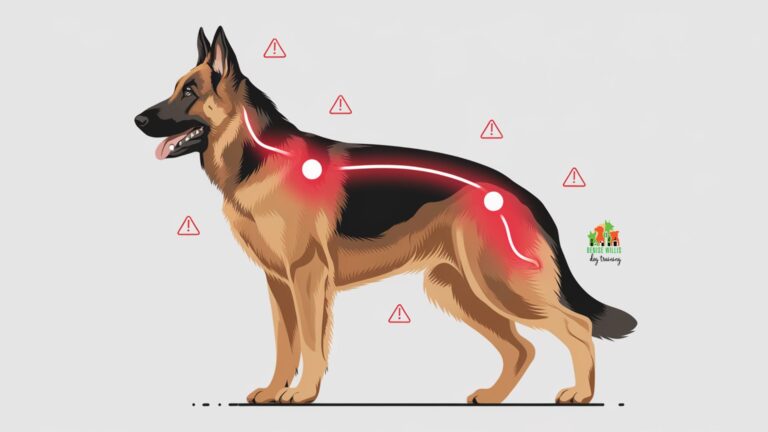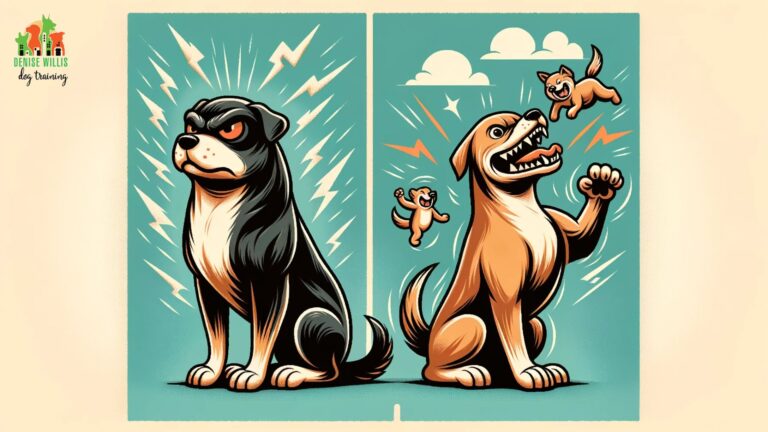The Dominance Myth: Why Your Dog Isn’t Trying to Take Over the World
📍 Service Area Notice: DW Dog Training provides in-person training services exclusively in the Greater Baltimore area. While our blog content is designed to help dog owners internationally, our hands-on training services are locally focused. For readers outside our service area, we hope you find value in our articles and welcome you to reach out with questions!
Is “dominance aggression” in dogs real, or are we barking up the wrong tree?
For years, dog owners have been told their pups are secretly plotting to overthrow the household hierarchy.
Spoiler alert: They’re not.
This outdated notion of canine behavior has led to misunderstandings, strained relationships, and ineffective training methods. It’s time to bust this myth wide open and get to the heart of what’s really going on with our four-legged friends.
Understanding the Dominance Myth
The concept of dominance in dogs has been a prevailing theory in dog training for decades. However, recent scientific studies have shed new light on canine behavior, challenging these long-held beliefs. Let’s explore the origins of this myth and why it’s time to move beyond it.
Debunking the Dominance Myth in Dog Training
Myth Origin
The dominance theory originated from misinterpreted studies of captive wolves in artificial settings, not representative of natural dog behavior.
True Dog Behavior
Dogs have flexible social structures and communicate through body language. Their behaviors are often motivated by seeking rewards, not dominance.
Positive Training
Effective dog training focuses on positive reinforcement, rewarding desired behaviors, and building trust rather than establishing dominance.
Addressing Issues
Behaviors often misinterpreted as dominance are usually due to fear, lack of training, or unmet needs. Address root causes for lasting change.
The Origins of the Dominance Myth
Back in the 1940s, some well-meaning scientists watched a bunch of unrelated adult wolves stuck together in a zoo enclosure. They saw fighting, posturing, and what looked like a strict pecking order. Naturally, they thought, “Hey, this must be how all canines operate!” Fast forward a few decades, and this idea had spread like wildfire in the dog training world.
But here’s the kicker: those captive wolves were about as representative of natural wolf behavior as a group of strangers locked in an elevator for a week would be of human society. Oops.
Debunking the Dominance Myth
Here’s the deal: your dog isn’t trying to be the alpha. They’re not plotting world domination from their dog bed. Modern science has thoroughly debunked the idea that dogs are constantly trying to climb some imaginary social ladder.
Wild wolf packs? They’re families, not furry fight clubs. The “alphas” are just mom and dad. And our domesticated dogs? They’re even further removed from this outdated theory. Dogs have evolved alongside humans for thousands of years, developing a unique ability to understand and cooperate with us that goes far beyond simplistic dominance hierarchies.
Timeline: Evolution of Dog Training Theory
1940s
Early misconceptions about dominance theory originate from studies of captive wolves by Rudolf Schenkel.
Read moreThese studies observed artificial packs of unrelated adult wolves in zoo settings, leading to misunderstandings about natural wolf and dog behavior.
1970
L. David Mech’s book “The Wolf” further popularizes the concept of a rigid alpha-beta-omega hierarchy in wolf packs.
Read moreThis book became highly influential in dog training circles, despite being based on outdated research.
1990s-2000s
More extensive research on wild wolf packs and domestic dogs begins to challenge earlier assumptions about dominance hierarchies.
Read moreStudies of wolves in natural settings reveal more complex and fluid social structures than previously thought.
2000s-2010s
The dominance theory becomes widely popularized in mainstream dog training, particularly through television shows and certain trainers.
Read moreDespite growing scientific evidence against it, dominance-based training methods gain popularity among dog owners.
2010-Present
Scientific research and modern dog training methods increasingly debunk the dominance myth.
Read morePositive reinforcement and force-free training methods gain traction as more effective and humane alternatives to dominance-based approaches.
Understanding True Dog Behavior
Now that we’ve debunked the dominance myth, let’s dive into what’s really going on with our canine companions. Understanding true dog behavior is key to fostering a healthy, happy relationship with your furry friend.

Canine Social Structures
Dogs are social creatures, sure, but their relationships are way more flexible than the old dominance theory suggested. They’re more interested in figuring out what works to get the good stuff (food, toys, attention) than in who’s the boss.
In a household, dogs often establish loose, situational hierarchies that can change depending on the resource in question. For example, one dog might always get first dibs on a favorite toy, while another might take the lead during walks. This fluid social structure is a far cry from the rigid dominance hierarchy once believed to exist.
Communication and Body Language
Dogs are constantly “talking” to us and each other through body language. What might look like dominance to the untrained eye is often just a dog saying, “I’m uncomfortable,” “I’m excited,” or “I have no idea what you want from me right now.”
Understanding canine body language is crucial for interpreting your dog’s needs and emotions. A wagging tail doesn’t always mean happiness, and a growl isn’t always aggression. By learning to read these subtle cues, you can better respond to your dog’s needs and prevent misunderstandings.
Motivations Behind Seemingly “Dominant” Behaviors
When a dog jumps up, pulls on the leash, or guards their food, they’re not staging a coup. They’re usually just doing what’s worked for them in the past to get what they want or need. It’s not personal, and it’s definitely not a power play.
For instance, a dog who jumps up on people is likely seeking attention or greeting in the only way they know how. A dog who guards their food might have experienced scarcity in the past. By understanding these underlying motivations, we can address the root cause of the behavior rather than labeling it as “dominance.”
The Negative Impact of Dominance-Based Training
Dominance-based training methods, rooted in outdated theories, can have serious negative consequences for both dogs and their human companions. Let’s examine why these approaches are problematic and potentially harmful.
Stress and Fear in Dogs
Trying to “dominate” your dog doesn’t create respect – it creates fear and anxiety. Would you feel great if someone kept trying to physically overpower you? Didn’t think so.
Dominance-based training often relies on intimidation and punishment. This can lead to chronic stress in dogs, which can manifest in various ways:
- Increased reactivity or aggression
- Decreased appetite
- Digestive issues
- Suppressed immune system
- Behavioral problems like excessive barking or destructive chewing
Remember, a stressed dog isn’t a happy dog, and certainly not a well-behaved one.
Deterioration of the Human-Dog Bond
Trust is the foundation of any good relationship, including the one with your dog. Dominance-based training can seriously damage that trust, making your dog see you as unpredictable or even scary.
When you use force or intimidation in training, you’re not building a cooperative partnership with your dog. Instead, you’re creating an atmosphere of fear and uncertainty. This can lead to:
- Reluctance to engage in training sessions
- Avoidance behaviors
- Decreased responsiveness to commands
- Loss of the joy and enthusiasm that make dog ownership so rewarding
Potential Increase in Aggressive Behaviors
Ironically, trying to squash “dominant” behaviors through force or intimidation can actually lead to more aggression. It’s like fighting fire with gasoline – not a great idea.
When dogs are repeatedly subjected to harsh corrections or physical punishments, they may learn that aggression is an appropriate way to deal with stress or conflict. This can result in:
- Increased growling, snapping, or biting
- Redirected aggression toward other pets or family members
- Escalation of minor issues into serious behavioral problems
In essence, dominance-based training can create the very problems it claims to solve.
Effective Alternatives to Dominance-Based Training
Now that we understand why dominance-based training is problematic, let’s explore more effective, science-based alternatives. These methods focus on building a positive relationship with your dog and teaching them what you want, rather than punishing what you don’t want.
Positive Reinforcement Techniques
Instead of focusing on being the “alpha,” focus on being a good teacher. Reward the behaviors you want to see more of. It’s not rocket science, but it works like a charm.
Positive reinforcement involves rewarding desired behaviors, which increases the likelihood of those behaviors being repeated. Here’s how to implement it:
- Identify the behavior you want to encourage
- Mark the behavior (with a clicker or a verbal marker like “yes!”)
- Immediately reward with something your dog values (treats, toys, praise)
- Repeat consistently
This method not only teaches your dog what you want but also makes training a fun, rewarding experience for both of you.
Force-Free Training Methods
You catch more flies with honey than vinegar, and you train more dogs with treats and praise than with force. Force-free methods are not only more humane, they’re also more effective in the long run.
Force-free training relies on setting your dog up for success and making the right choices easy and rewarding. This can include:
- Management: Preventing unwanted behaviors by controlling the environment
- Redirection: Offering an alternative, acceptable behavior
- Desensitization and counterconditioning: Changing your dog’s emotional response to triggers
These methods focus on teaching your dog what to do, rather than punishing them for what not to do.
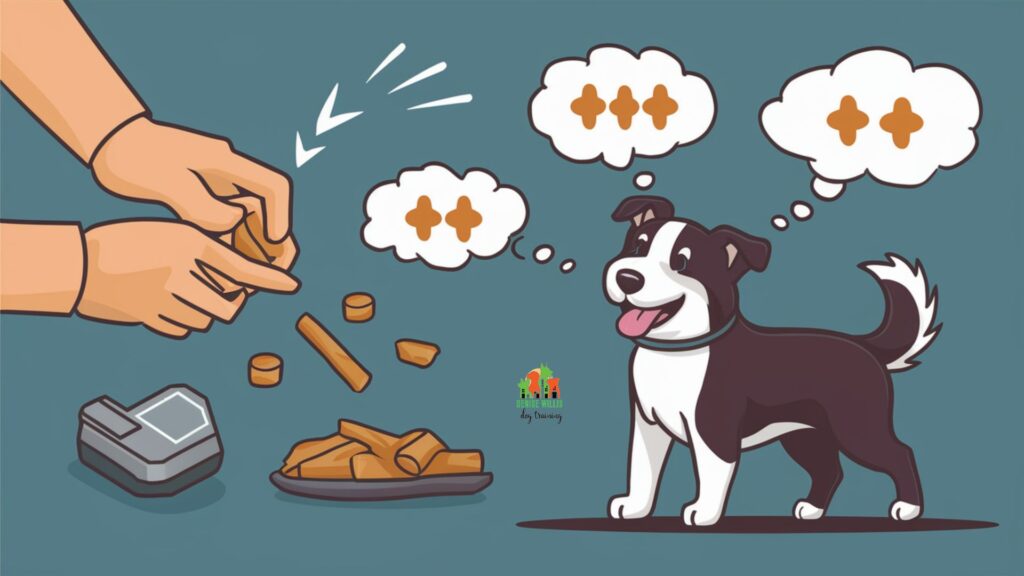
Building Trust and Cooperation
The goal isn’t to make your dog submit to you. It’s to build a partnership based on mutual trust and understanding. When your dog sees you as a source of good things rather than someone to be feared, everyone wins.
Building trust and cooperation involves:
- Clear, consistent communication
- Respecting your dog’s boundaries and individual personality
- Providing mental and physical stimulation
- Being a predictor of good things in your dog’s life
Remember, a trusting, cooperative relationship is the foundation for all successful training.
Addressing Specific Behavior Issues
Many common dog behavior problems are often misinterpreted as dominance issues. Let’s look at some of these behaviors and how to address them using positive, force-free methods.
Resource Guarding
If your dog growls over their food or toys, they’re not trying to be the boss. They’re worried about losing something valuable. The solution? Make them feel secure, not threatened.
Resource guarding is often rooted in insecurity or past experiences of scarcity. To address it:
- Respect your dog’s space during mealtimes
- Teach a solid “leave it” and “drop it” command using positive reinforcement
- Practice trading high-value items for even better rewards
- If severe, consult a professional trainer or behaviorist for a tailored plan
Remember, punishment can make resource guarding worse, so always use positive methods.
Leash Pulling
Your dog isn’t trying to lead the pack when they pull. They’re just excited and haven’t learned to walk nicely yet. Teach them that walking beside you is more rewarding than pulling ahead.
To address leash pulling:
- Stop moving forward when your dog pulls
- Only proceed when the leash is loose
- Reward your dog for walking close to you
- Practice in low-distraction environments first
- Use tools like front-clip harnesses if needed
Consistency is key – every walk is a training opportunity.
Jumping Up on People
This is your dog’s way of saying “Hi there! I’m so excited to see you!” It’s not about dominance – it’s about needing to learn better greeting manners.
To curb jumping:
- Ignore jumping behavior – don’t push the dog away or knee them
- Only give attention when all four paws are on the floor
- Teach and reward an alternative greeting behavior, like sitting
- Ask visitors to help by following the same rules
With consistency from everyone, your dog will learn that calm greetings get rewarded.
The Role of Leadership in Dog Training
While the concept of “dominance” in dog training is outdated, the idea of leadership is still relevant. However, it’s important to understand what true leadership means in the context of the human-dog relationship. Let’s explore how to be an effective leader for your canine companion.
Providing Structure and Guidance
Being a leader to your dog doesn’t mean being a dictator. It means providing clear, consistent guidelines and helping your dog navigate the human world.
Effective leadership involves:
- Setting clear boundaries and rules
- Consistently enforcing these rules in a calm, fair manner
- Providing routine and predictability in your dog’s life
- Guiding your dog through new or challenging situations
Remember, your dog looks to you for guidance. By providing structure, you’re helping them feel secure and understand their place in your household.
Consistency and Clear Communication
Dogs thrive on routine and clear expectations. When they know what you want and what to expect, they’re much more likely to behave in ways you like.
To communicate clearly with your dog:
- Use consistent cues for commands
- Ensure all family members use the same cues and rules
- Reward desired behaviors promptly and consistently
- Avoid confusing or contradictory signals
Clear communication reduces frustration for both you and your dog, leading to a more harmonious relationship.
Meeting Your Dog’s Physical and Mental Needs
A well-exercised, mentally stimulated dog is usually a well-behaved dog. Make sure your pup is getting enough physical activity and brain games.
To meet your dog’s needs:
- Provide daily exercise appropriate to your dog’s age, breed, and health status
- Offer mental stimulation through training, puzzle toys, and interactive games
- Allow for natural dog behaviors like sniffing and exploring during walks
- Ensure your dog has a balanced diet and proper veterinary care
By meeting these needs, you’re setting your dog up for success and preventing many behavior problems before they start.
When to Seek Professional Help
While many dog behavior issues can be addressed at home with patience and positive training methods, there are times when professional help is necessary. Recognizing when you need expert assistance is a crucial part of responsible dog ownership.
Signs That Indicate Professional Intervention is Needed
If you’re struggling with your dog’s behavior, don’t wait until things get out of hand. Some signs you might need pro help include:
- Aggression towards people or other animals
- Extreme fear or anxiety
- Destructive behaviors
- Persistent house training issues
- Compulsive behaviors like excessive licking or tail-chasing
- Any behavior that puts your dog or others at risk
- Sudden changes in behavior that might indicate a medical issue
If you’ve tried addressing these issues on your own without success, or if you feel overwhelmed, it’s time to call in a professional.
Choosing a Qualified Dog Trainer or Behaviorist
Look for trainers who use positive, science-based methods. Avoid anyone who talks about “dominance” or suggests harsh punishments. A good trainer should be able to explain their methods and why they work.
When selecting a professional:
- Look for certifications from reputable organizations
- Ask about their training philosophy and methods
- Inquire about their experience with your specific issue
- Request references from past clients
- Ensure they’re willing to work with your veterinarian if necessary
Remember, a good trainer will include you in the training process and teach you how to continue working with your dog.
What to Expect from Professional Behavior Modification
A qualified professional will assess your dog’s behavior, create a tailored training plan, and teach you how to implement it. They’ll also provide ongoing support as you and your dog work together.
The process typically involves:
- An initial consultation to gather information about your dog and the issue
- A behavior assessment to observe your dog in their environment
- Development of a customized training plan
- Hands-on training sessions to teach you and your dog
- Follow-up support to address any challenges and adjust the plan as needed
Professional help can be a game-changer for many dogs and their owners, providing the skills and support needed to overcome challenging behaviors.
Frequently Asked Questions About Dominance aggression in dogs
How can I stop dominance aggression between dogs?
First off, let’s ditch the term “dominance aggression.” What you’re likely seeing is resource guarding, fear, or just plain old poor social skills. The key is to identify the trigger and work on positive associations. For example, if Dog A gets growly when Dog B approaches their food bowl, start by feeding them separately. Gradually, over time, you can teach Dog A that good things happen when Dog B is near their food. Maybe Dog B’s presence means extra treats fall from the sky!
What is dominance aggression in a dog?
“Dominance aggression” is an outdated term that’s not really used by modern behaviorists. What people often label as dominance aggression is usually fear-based aggression, resource guarding, or learned aggressive behaviors. Instead of trying to label the behavior, focus on the specific triggers and work on addressing those with positive reinforcement techniques.
Can a dominant, aggressive dog be rehabilitated?
Absolutely! But let’s reframe this. Instead of thinking about a “dominant, aggressive dog,” think about a dog who’s learned some inappropriate behaviors. With consistent, positive training methods, most dogs can learn new, more appropriate ways of interacting with their environment. It takes time and patience, but the results are worth it.
What’s the difference between dominance and aggression in dogs?
Here’s the thing: dominance isn’t really a personality trait in dogs. It’s more of a relationship between two individuals that can change depending on what’s at stake. Aggression, on the other hand, is a behavior that dogs may use in certain situations – often out of fear or insecurity, not a desire to “dominate.” Instead of focusing on dominance, it’s more helpful to look at the specific behaviors and what’s motivating them.
Key Takeaways
- The dominance theory in dog training is outdated and potentially harmful.
- Dogs aren’t trying to dominate us – they’re just being dogs.
- Positive reinforcement and force-free methods are more effective than dominance-based training.
- Understanding dog body language is key to addressing behavior issues.
- Meeting your dog’s physical and mental needs goes a long way in preventing problem behaviors.
- Professional help can be invaluable for serious behavior issues.
- Building a relationship based on trust and clear communication is the goal, not establishing yourself as the “alpha.”
Recommended Products for Managing Dominance Aggression in Dogs
While addressing dominance aggression primarily involves training and behavior modification, certain products can support your efforts. Here are some items that can be helpful when working with a dog exhibiting aggressive behaviors:
- Front-Clip Harness: A front-clip harness like the PetSafe Easy Walk Harness can provide better control during walks, reducing pulling and allowing you to redirect your dog’s attention more easily.
- Calming Aids: Natural calming supplements like Zesty Paws Calming Bites can help reduce anxiety, which is often underlying aggressive behaviors.
- Muzzle: For severe cases, a well-fitted basket muzzle like the Baskerville Ultra Muzzle allows for safe interactions during training sessions. Remember, a muzzle is a management tool, not a solution.
- Long Training Lead: A long lead such as the Leashboss Long Dog Training Leash allows for distance training and recall practice in a controlled environment.
- High-Value Treats: When working on behavior modification, you’ll need extra-special treats. The Stella & Chewy’s Freeze-Dried Raw Dinner Patties can be broken into small, irresistible pieces.
Remember, these products are aids in training and management, not solutions on their own. Always consult with a professional trainer or behaviorist when dealing with aggression issues.
Further Reading
To deepen your understanding of dog behavior and training, especially in relation to aggression and the dominance myth, consider exploring these related articles:
- 5 Proven Strategies to Stop Your Dog’s Aggression Towards Other Dogs: This article provides practical tips for managing dog-to-dog aggression, a common issue often misattributed to dominance.
- Decoding Your Dog: 15 Body Language Signals You Need to Know: Understanding canine body language is crucial in identifying the real reasons behind seemingly aggressive behaviors.
- How to Manage Your Dog’s Territorial Aggression: This guide offers insights into territorial behaviors often mistaken for dominance aggression.
- The Shy Dog’s Guide to Conquering Fear: 10 Simple Techniques: Fear is often at the root of aggressive behaviors. This article provides strategies for helping fearful dogs gain confidence.
- Dog Aggression Solutions: A Complete Guide to Stopping Aggressive Behavior in Dogs: This comprehensive guide delves deeper into various types of dog aggression and their solutions.
These resources offer valuable information to help you better understand and address your dog’s behavior, moving beyond the outdated concept of dominance aggression.

Put Your Knowledge to the Test: The Dominance Myth Quiz
Alright, future dog whisperers, it’s time to see if you’ve been paying attention. We’ve covered a lot of ground busting the dominance myth wide open, and now it’s your turn to show what you’ve learned. Don’t worry, this isn’t like those pop quizzes from school that used to make your palms sweat. This is your chance to prove you’re ready to be the kind of dog owner that makes other pups at the park jealous.
So, grab your imaginary clicker, put on your thinking cap (or your favorite treat-dispensing pocket), and let’s dive into this quiz. Remember, every question you get right is another step towards building an awesome relationship with your furry friend. And hey, if you don’t ace it on the first try, no worries – that’s what second chances (and treats) are for!
Ready to prove you’re top dog when it comes to understanding canine behavior?
Let’s get started!
Test Your Knowledge: Dog Dominance Myth Quiz
Well, how’d you do?
Whether you aced it or learned a thing or two, give yourself a pat on the back (or a treat, we don’t judge). The fact that you’re here, learning about modern, science-based dog training, puts you miles ahead of the pack.
Remember, understanding your dog isn’t about being the “alpha” or the “pack leader.” It’s about building a partnership based on trust, clear communication, and positive reinforcement. Every step you take away from the outdated dominance theory and towards force-free methods is a step towards a happier, more confident dog.
Final Thoughts
Alright, let’s wrap this up. The dominance myth in dog training has been hanging around like a bad smell for way too long. It’s time to air out our understanding of dog behavior and embrace methods that actually work – and don’t stress out our furry friends in the process.
Remember, your dog isn’t plotting to overthrow you. They’re just trying to navigate a world that sometimes doesn’t make sense to them. By using positive, force-free training methods, you’re not just teaching your dog – you’re building a stronger, more trusting relationship.
Now, I’d love to hear from you.
Have you struggled with behaviors that you thought were related to dominance?
What methods have you tried, and how did they work out?
Drop a comment below and share your experience. Your story could help other dog owners who are facing similar challenges.
And hey, if you’re feeling overwhelmed or unsure about how to address your dog’s behavior, don’t hesitate to reach out for professional help. At DW Dog Training, we’ve been helping dogs and their humans build better relationships for years. We use science-based, positive methods to address a wide range of behavior issues – no dominance nonsense required.
Ready to move beyond the dominance myth and start building a better relationship with your dog? Contact us to learn more about our services or to schedule a consultation. Let’s work together to create a happier, more harmonious life for you and your canine companion.
So, what’s been your biggest challenge in understanding and addressing your dog’s behavior? Have you ever bought into the dominance myth, and if so, how did it affect your relationship with your dog?
Share your thoughts and experiences in the comments – let’s learn from each other and bust this myth once and for all!

